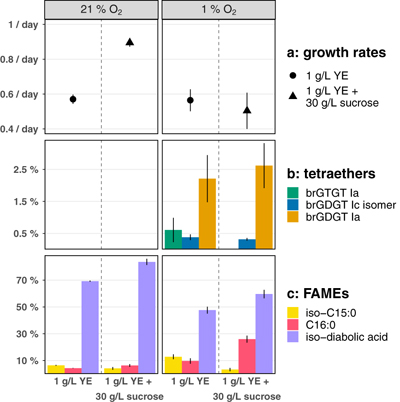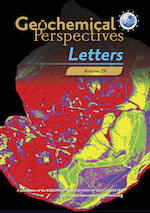Corrigendum to “Oxygen limitation can trigger the production of branched GDGTs in culture” by Halamka et al., 2021
Affiliations | Corresponding Author | Cite as- Share this article





-
Article views:1,037Cumulative count of HTML views and PDF downloads.
- Download Citation
- Rights & Permissions
top
Corrigendum
Correction to: Geochemical Perspectives Letters 19, 36–39, doi: 10.7185/geochemlet.2132, published 3 November 2021.
Revised abstract
The wording of the abstract was revised to accommodate a request for clarification on how the new findings fit into the existing literature context. Specifically, three sentences in the abstract were changed, the name of the bacterium used here was added, and the degrees of brGDGT production and oxygen limitation were specified. The revised abstract is shown below.
Abstract: Branched glycerol dialkyl glycerol tetraethers (brGDGTs) are ubiquitous and well-preserved sedimentary biomarkers. These compounds serve as important palaeoenvironmental indicators due to strong empirical correlations between brGDGT distributions and temperature and pH in modern environments. However, the mechanistic link between temperature, pH, and brGDGT production has been difficult to study due to uncertainty about the organisms and physiological conditions required for the synthesis of brGDGTs in nature. Here, we report that in the Acidobacterium Edaphobacter aggregans, severe oxygen limitation (1% O2) leads to significant brGDGT production (2.9% of membrane lipids) with three structural varieties including an uncharacterised isomer of brGDGT Ic. Low O2 as a physiological trigger for brGDGT production may help explain why brGDGT producers have been so difficult to identify, and provides a new path towards uncovering the genetic basis and biological function of brGDGTs. If the oxygen effects observed here apply more broadly, the empirical calibrations for brGDGT-based temperature and pH reconstructions may currently be missing the effects of oxygen as a relevant and possibly dominant control in the environmental distributions of brGDGTs.
Corrected Figure 1
The y-axis label of the growth rates panel (a) of Figure 1 erroneously stated the axis scale as 1/hr instead of the correct 1/day. All other references to the growth rate values in the text and Supplementary Information are correct (stating the units as 1/day). The corrected figure is shown here.

Figure 1 Growth rate and lipid membrane profiles of E. aggregans grown in liquid culture at 21 % O2 (= air, left) and 1 % O2 (right) with and without carbon excess. Data points represent averages and standard deviations of biological triplicates. (a) Growth rates with medium containing 1 g/L Yeast Extract (YE, circle) and 1 g/L YE + 30 g/L sucrose (triangle). (b) Tetraethers [% of all detected core lipids]: brGTGT Ia (green), brGDGT Ic isomer (blue), brGDGT Ia (orange). No tetraethers were detected at 21 % O2. (c) Most abundant FAMEs (Fatty Acid Methyl Esters, % of all detected core lipids): iso-C15:0 (light yellow), C16:0 (red), iso-diabolic acid (purple).







